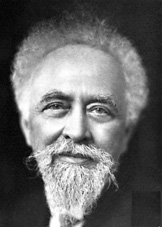Jean Baptiste Perrin
| Jean Baptiste Perrin | |
 |
|
| Born | 30 September 1870 Lille, France |
|---|---|
| Died | 17 April 1942 (aged 71) New York City, USA |
| Nationality | France |
| Fields | Physics |
| Alma mater | École Normale Supérieure |
| Known for | Nature of cathode rays Brownian motion Sedimentation equilibrium |
| Notable awards | Nobel Prize in Physics (1926) |
Jean Baptiste Perrin (30 September 1870 – 17 April 1942) was a French physicist and Nobel laureate.
Contents |
Biography
Early years
Perrin was born in Lille, France where he attended the École Normale Supérieure. He became an assistant at the school during the period of 1894-97 when he began the study of cathode rays and X-rays. He was awarded the degree of docteur ès sciences (PhD) in 1897. In the same year he was appointed as a lecturer in physical chemistry at the Sorbonne, Paris. He became a professor at the University in 1910, holding this post until the German occupation of France during World War II.
Research
In 1895, Jean Perrin showed that cathode rays were made of corpuscles with negative electric charge. He computed Avogadro's number through several methods. He explained solar energy by the thermonuclear reactions of hydrogen.
After Albert Einstein published (1905) his theoretical explanation of Brownian motion in terms of atoms, Perrin did the experimental work to test Einstein's predictions, thereby settling the century-long dispute about John Dalton's atomic theory.
Jean Perrin received the Nobel Prize in Physics in 1926 for his work on the discontinuous structure of matter, and especially for his discovery of sedimentation equilibrium.
Perrin was the author of a number of books and dissertations. Most notable of his publications were: "Rayons cathodiques et rayons X" ; "Les Principes"; "Electrisation de contact"; "Réalité moléculaire"; "Matière et Lumière"; "Lumière et Reaction chimique".
Perrin was also the recipient of numerous prestigious awards including the Joule Prize of the Royal Society in 1896 and the La Caze Prize of the Paris Academy of Sciences. He was twice appointed a member of the Solvay Committee at Brussels in 1911 and in 1921. He also held memberships with the Royal Society of London and with the Academies of Sciences of Belgium, Sweden, Turin, Prague, Romania and China. He became a Commander of the Legion of Honour in 1926 and was made Commander of the Order of Léopold (Belgium).
In 1927, he jointly founded the Institut de Biologie Physico-Chimique and in 1937 the Palais de la Découverte, a science museum in Paris.
One of his students was Pierre Victor Auger. Perrin was the father of Francis Perrin, also a physicist.
Personal life
Perrin was an officer in the engineer corps during World War II. When the Germans invaded France in 1940, he escaped to the U.S.A. where he died in New York City. After the War, in 1948, his remains were transported back to France by the battleship Jeanne d'Arc and buried in the Panthéon.
References
- Kyle, R A; Shampo M A (1979). "Jean Baptiste Perrin". JAMA 242 (8): 744. doi:. PMID 379381.
External links
- 1926 Nobel Prize
- Atoms, translated by Dalziel Hammick, in the Internet Archive
|
||||||||